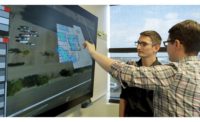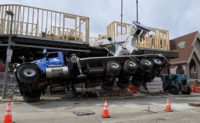In line with this philosophy, I have kept in touch with masons throughout the course of this project to learn about the challenges of the trade and how technology could be of service to the profession. My students got on the phone with a member of the Mason Contractors Association of America to have a similar discussion before embarking on design.
Through these conversations, we found that masons are a skilled class in high demand. We also discovered that it can sometimes be difficult to find assistants to do the backbreaking work of hauling materials.
That’s where our robots would come in.
We determined that to be successful on a construction site, they must be strong, lightweight and agile enough to navigate difficult terrain. They need to climb, of course. And they need to be able to keep track of how their surroundings are changing (thus, the smart glasses, which would wirelessly link the robot to not only the masons but also to offsite Building Information Modeling systems – virtual simulations that provide a picture of how a construction project is proceeding in space and time.)
We have just begun developing the glasses, and the engineers on our team are in the process of programming the third prototype of our robot, OSCR-3. It just learned to walk, and we’ll be teaching it to climb a ladder while carrying bricks.
To build these early bots, UB architecture students fashioned plastic parts on a 3-D printer and tested different designs for various “body parts.” OSCR-3 features carbon fiber ribs which frame the robot, contain its wires and serve as handles.
The experience has been wonderful for all of our students. Many come from a construction background and are very interested in how they can make these tools useful in industry.
Our project is still a few years from completion, but so far, it has been a fascinating experience.
Moving robots out of the factory and into the field is an important next step. Technology, created and used in the right way, has great potential to improve the lives of people. But it is also important, at this early stage, for designers to imagine new systems that manage the complex social and economic exchanges that automation often disrupts. Big questions need to be posed in the process. How will new tools impact the already tense relationship between management and labor, profits and jobs? Can designers create tools that respect human labor while increasing contractor profits? Does the shift from robots that work in factory cages to co-robotics that work closely with people offer any new solutions? These are still open questions but they are ones that the profession can address, especially now that architects are less tied to the appropriation of existing digital hardware and more actively engaged in their creation.





Post a comment to this article
Report Abusive Comment